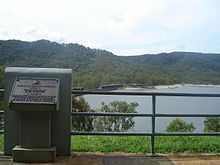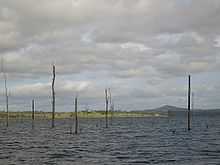Lake Tinaroo
| Lake Tinaroo | |
|---|---|
 | |
| Location | Far North Queensland |
| Coordinates | 17°09′49″S 145°32′50″E / 17.16361°S 145.54722°ECoordinates: 17°09′49″S 145°32′50″E / 17.16361°S 145.54722°E |
| Lake type | reservoir |
| Primary inflows | Barron River |
| Primary outflows | Barron River |
| Catchment area | 545 km2 (210 sq mi) |
| Basin countries | Australia |
| Surface area | 3,500 ha (8,600 acres) |
| Max. depth | 41.8 m (137 ft) |
| Water volume | 438,900 ML (15,500×106 cu ft)[1] |
| Shore length1 | 209 km (130 mi) |
| Surface elevation | 670.4 m (2,199 ft) |
| References | [1] |
| 1 Shore length is not a well-defined measure. | |
Lake Tinaroo, also known as Tinaroo Dam, is a man-made reservoir on the Atherton Tableland in Far North Queensland, Australia. It was constructed between 1953 and 1958 on the Barron River close to Lake Barrine and Lake Eacham (Yidyam).
History
In 1952, The Tinaroo Dam and Mareeba-Dimbulah Irrigation Scheme was approved by the state government. Construction on the dam was started in 1953 and completed in 1958, at a cost of $12,666,000. The dam wall is 45.1 metres high and traps enough water from the Barron River to create a lake 3/4 the size of Sydney Harbour with a capacity of 407,000 megalitres. When the dam was filled in 1959, the old township of Kulara near Yungaburra went underwater, and all of the residents relocated to Yungaburra and surrounding towns (see Unexpected flooding below).

The area around Kulara was among the last to flood when the dam filled. Earlier the area of Danbulla, located on Robson's Creek - which also feeds into the lake, went underwater. Most of these residents relocated to the tablelands area as their farms were resumed.
The name "Tinaroo"
James Mulligan was the first European explorer and prospector to visit the tablelands in 1875. The area is now called "The Atherton Tableland" after John Atherton who settled at Emerald End Station, at the junction of Emerald Creek and the Barron River. It is reported through popular legend that upon discovering alluvial tin at the headwaters of the creek, Mr Atherton shouted "Tin, Harroo!!" to his prospecting mate - hence the name.
Unexpected flooding
After the dam was completed in 1958, there was expected to be another few months before the annual rains to do some final earthworks at the base of the dam, and to clear out the final settlements in the area. Unfortunately the rains began earlier than expected and to this day there are still some pieces of large construction equipment under water at the base of the dam wall, because they were not able to be removed in time.
Creating a Dam
The dam filled in the first instance according to a schedule. Once construction on the last monolith had raised it above the outlet pipes the dam wall was sealed off using a planned procedure where the prepared tunnel under monolith 19 was closed. This allowed the dam to start filling up to the river outlet level.The dam filled progressively over the next few years and did not actually overflow until 1963, far later than originally expected.
Water uses
Irrigation
Covering almost 1,200 square kilometres, the Mareeba-Dimbulah Irrigation Area is spread across the valleys of the Barron, Walsh and Mitchell Rivers.
415 square kilometres of farmland are irrigated by the lake when it supplies its 205,000 megalitres of water each year. Farmers access this water from the extensive network of 176 kilometres of channels using either a gravity fed system or pumps. Areas not serviced by the channels can draw water from streams that have their water replenished by the Barron River, which, in turn, is fed by the lake.
Power generation
The Tinaroo Hydro Power Station became operational in May, 2004 and generates 1.6 megawatts, thereby stopping 8,450 tons of carbon dioxide from entering the atmosphere each year. The dam is used to regulate the waterflow for use at the Barron Gorge Power Station.
Urban water supply
The townships of Tinaroo, Walkamin, Mareeba, Kuranda, Mutchilba, Dimbulah and Yungaburra are supplied from Tinaroo Dam through the Barron River.
Maintenance
According to the SunWater there are no current plans to upgrade capacity. The upgrade consists of reinforcing the dam to increase safety, in its current capacity.
Recreation
Located on the picturesque Atherton Tableland, with the Tinaroo Range and the Danbulla State Forest surrounding it, Lake Tinaroo provides a popular tourist attraction and recreation facility for over 500,000 people a year.
Water sports

With over 200 kilometres of shoreline, Lake Tinaroo offers many bays with smooth water that are protected from the wind. To this end, the lake is often used for sailing, water skiing, houseboating and swimming. During the drought of the last few years, some of the trees that were flooded during the dam's creation have become a hazard to boats because of the receding waters. The park services that maintain the recreational areas of the dam have had to trim the dead trees that have appeared. Thankfully the dam's waters are now higher, so this is no longer a problem. There are still large areas of flooded vegetation, including trees and other man-made objects such as telephone poles, which stand around in the waters of the Lake. The degree of exposure varying with the water level. As far as I know the policy of the people that control the Lake is that standing timber should remain as fish habitat. There have been a few instances of unauthorised clearing of dead trees in some areas of the Lake.
Hiking
The lake is surrounded by national park, rainforest, pine tree plantations and Australian "bush". Hiking paths wind in and out of the mountains surrounding the lake and range from a pleasant walk from the parking lot to the water-front, to week long treks around the lake and its mountains.
Fishing
Many species of fish and other aquatic animals populate the lake. The barramundi can grow to an enormous size in the lake because they have no natural predators. Each year, the lake is stocked with young barramundi from the Walkamin Research Station as the species is unable to breed in the lake due to the lack of access to salt water. Also present in Lake Tinaroo are eel-tailed catfish, sooty grunter, sleepy cod, mouth almighty, archer fish, spangled perch, long tom and many species of crayfish, including the red-claw and yabby.
A Stocked Impoundment Permit is required to fish in the dam.
Tilapia were illegally introduced into Lake Tinaroo and are now well established. They have been declared a noxious pest species and must be destroyed and buried if caught. It is illegal to possess, rear, sell or buy tilapia. It is also an offence to release tilapia into Queensland waterways or to use them as bait, live or dead.
Statistics
- Average annual rainfall: 1 300 mm
- Annual yield for irrigation: 205 000 ML
- Assured yield for power generation: 72 000 ML
- Full supply level: 670 m above sea level
- Length of storage: 15 km
- Type of structure: Mass concrete gravity dam
- Height of wall: 45.1 m
- Maximum base width: 35.4 m
- Total crest length: 533.4 m
- Quantity of concrete: 223 000 m³
- Quantity of rock removed for foundations: 153 000 m³
- Spillway type: Ungated, central ogee spillway
- Spillway dimensions: 76.2 x 3.7 m
- Flood inflow (maximum): 256 000 ML/day
- Spillway discharge (maximum): 106 000 ML/day
- Irrigation outlets: 2 x 1 500 mm radial gates
- Barron River outlet: 1 x 1 500 mm cone valve
- Period of construction: 1953 - 1958
- Cost: $12,600,000
See also
- List of dams and reservoirs in Australia
- Mount Hypipamee Crater
- Mount Quincan
- The Seven Sisters
References
External links
| Wikimedia Commons has media related to Lake Tinaroo. |
- Fishing information with lake map at Sweetwater Fishing Lake Tinaroo
- Tinaroo Education Centre
| ||||||||||||||